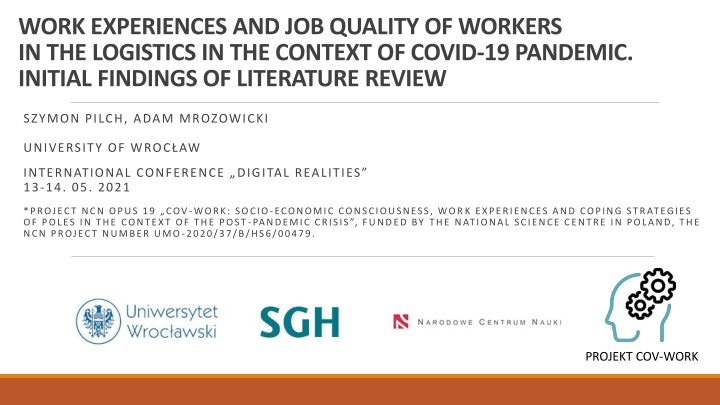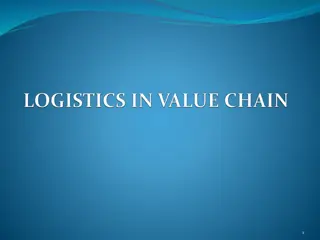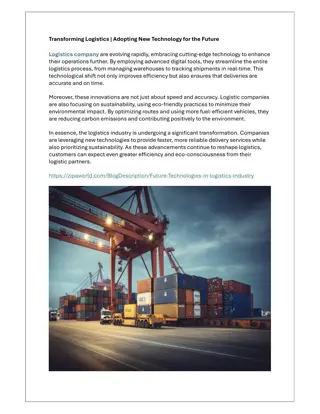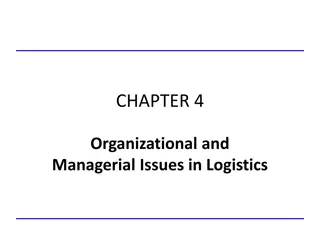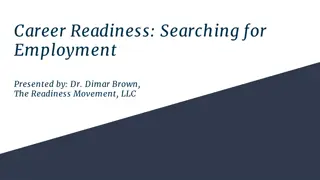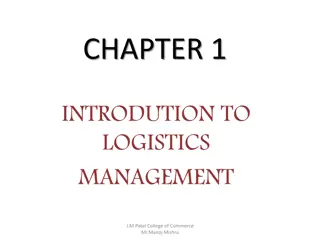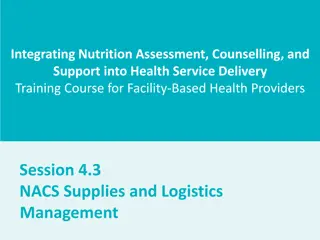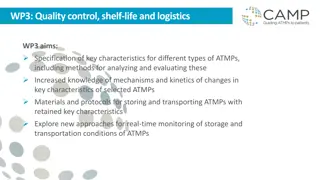Impact of COVID-19 on Job Quality in Logistics: Initial Literature Review Findings
The COV-WORK project explores how the pandemic has affected job quality and work experiences in the logistics industry, focusing on lorry drivers, logistics center employees, and couriers. The study examines job quality dimensions such as income, job security, work pressure, skills, autonomy, and more, anticipating potential deteriorations due to the pandemic's influence. Gendered and classed declines in job quality are expected, particularly impacting vulnerable labor market segments. This research aims to understand the evolving landscape of work organization and job quality in logistics during and post-pandemic conditions.
Download Presentation

Please find below an Image/Link to download the presentation.
The content on the website is provided AS IS for your information and personal use only. It may not be sold, licensed, or shared on other websites without obtaining consent from the author.If you encounter any issues during the download, it is possible that the publisher has removed the file from their server.
You are allowed to download the files provided on this website for personal or commercial use, subject to the condition that they are used lawfully. All files are the property of their respective owners.
The content on the website is provided AS IS for your information and personal use only. It may not be sold, licensed, or shared on other websites without obtaining consent from the author.
E N D
Presentation Transcript
WORK EXPERIENCES AND JOB QUALITY OF WORKERS IN THE LOGISTICS IN THE CONTEXT OF COVID-19 PANDEMIC. INITIAL FINDINGS OF LITERATURE REVIEW SZYMON PILCH, ADAM MROZOWICKI UNIVERSITY OF WROC AW INTERNATIONAL CONFERENCE DIGITAL REALITIES 13-14. 05. 2021 *PROJECT NCN OPUS 19 COV-WORK: SOCIO-ECONOMIC CONSCIOUSNESS, WORK EXPERIENCES AND COPING STRATEGIES OF POLES IN THE CONTEXT OF THE POST-PANDEMIC CRISIS , FUNDED BY THE NATIONAL SCIENCE CENTRE IN POLAND, THE NCN PROJECT NUMBER UMO-2020/37/B/HS6/00479. PROJEKT COV-WORK
INTRODUCTION The COV-WORK project aiming at the exploration of the consequences of pandemic for socio-economic consciousness, life strategies and social dialogue: the logistics as one of the industries studied in the project (along with education, health care and HORECA industries) Logistics as one of the essential work industries, with the increase in demand observed during pandemic: work intensification, high risk of infection adding to the earlier factors of precarisation Focusing on three sections of the broadly understood logistics: lorry drivers, logistics centres employees and couriers (in the further research: also employed via platforms) Literature and secondary data review supplemented by a pilot expert interview at Amazon Research question: if and how work organisation and job quality in logistics have changed as result of pandemic? Hypothesis of the pandemic as the catalyst of trends observed in pre-pandemic period: precarisation, digitalised control over work, automation
JOB QUALITY DIMENSIONS Six dimensions of job quality: income, job security and prospects, work pressure, skills and autonomy, unsocial hours, and working time control and flexibility (Eurofound 2020a; Gallie 2013) (here limited to: remuneration; working time; work pressure; lack of data) Growing risks of job quality deterioration as result of subsequent capitalist crises and the increased imbalance between the capital and labour; Gendered and classed decline of job quality as result of COVID-19 pandemic expected (Eurofound 2020b; Harvey 2020): those in the periphery of labour market ( new working class Harvey 2020) are most prone to suffer job quality decline and most exposed to the health-related risks during pandemic due to limited level of institutional protection and limited access to privately funded schemes ; Other aspects of job quality deterioration: (1) job loses in the case of temporary / precarious workers who function as labour market buffer; (2) gendered challenges to work-life balance (due to the closure of schools the double work of (mostly female) family members; (3) higher variation of pay and working time due to the cycles of lockdowns / opening of economy;
LOGISTIC SECTOR IN POLAND Logistics as all companies involved in transport (forwarding), warehousing, handling and legal and formal support of sales of goods (Czerniak 2017: 7) Over 800,000 workers in 2017, medium/low level of FDIs (12% of employees in foreign owned companies); over half in small and micro companies = high competition in the sector; pre-pandemic increase in the number of workers; The main segments: road transport; storage and handling goods and postal and courier services (also studied in this project); Relatively high unionisation of rail transport and postal services, limited in other sections in the sector COVID-19 contributes to the increased demand on logistic services and further expansion of the sector; relative optimism of employers
LITERATURE REVIEW FINDINGS (I) LORRY / TRUCK DRIVERS a) especially vulnerable group due to Covid-19 acquiring and further contracting of a virus, as well as age, health issues, long working hours (up to 13 per day in pre-pandemic time, see Lemke et al. 2021), work pressure - COVID 19 based truck driver syndemic (Lemke, Apostolopoulos 2020); b) In the Polish context low unionisation, no collective agreements, challenges of working time regulation (e.g. with respect to idle time/loading/unloading); high relevance of the variable components of pay (Social conditions in logistics .) c) lack of protective policies against COVID-19 infection and protective gear provided by the employer, fear of losing jobs, income and of decrease in demand for goods (Lemke et al. 2020; Garsten 2020; Costello 2020; Qin et al. 2021); d) Unfavorable working conditions such as: lack of protective gear and risk of contracting the virus, as well as fear of public health are partially confirmed in media coverage*.
LITERATURE REVIEW FINDINGS (II) LOGISTICS CENTRES EMPLOYEES / WAREHOUSE WORKERS a) Poland as one of attractive destinations for logistics centres due to low wages and geographical location; in pre-pandemic period, high level of precarity observed (extensive use of TWAs, long shifts, high level of indirect control, high pace of work Owczarek, Che stowska 2016: 86) b) warehouse workers report deterioration in perception of job security, in level of workplace health, behavioral safety compliance and risk of Covid-19 infection (Chi et al. 2020); c) multiple workers reports in media concerning fear going out to work caused by lack of protective gear, and fiction of pandemic regulations at workplace, lack of social distancing (The Guardian 2020; The New York Times 2020a; The NYT 2020c; Gazeta Wyborcza 2020a); d) reports in media of an increase in cases of infected warehouse workers since March-April 2020 (The NYT 2020a); e) reports in media of working overtime and absenteeism in US, e. g. 30% of warehouse workers absent at distribution centres by mid-March 2020; raise of hourly-wage (in US); union activity aimed at protecting workers at warehouses (The NYT 2020a, The NYT 2020b, Gazeta Wyborcza 2020b).
LITERATURE REVIEW FINDINGS (III) COURIERS EMPLOYED BY DELIVERY COMPANIES / PARCEL-DELIVERY COURIERS a) Comparing to findings on previous groups, there is a scant of data on the situation during pandemic except for gig economy workers; b) In the pre-pandemic period: high incidence of dependent self-employment (Podawca 211) in the case of new privately-owned delivery companies; deterioration of work also observed following the changes at the Polish Post (Kozek and Radzka 2011); high exposure to health-related risks among couriers (Kubisa 2019) c) Reported increase in demand for courier services since the start of COVID-19 pandemic (Dones, Young 2020), up to 110% on some of the e-commerce goods (Gruenwald 2020); increase in wages of gig deliverly workers at the beginning of pandemic (Polkowska 2020) followed by their decline as result of increased internal competition in the sector (Muszynski et al., forth.) d) A high risk of Covid-19 infection (Mar and Pulignano 2020) and lack of sick pay in case of those working in gig economy; e) An increase in working time*; first protests of gig economy couriers in Bialystok in April 2021;
POST-PANDEMIC PROGONOSIS? GENERAL PROGNOSIS DETAILED FORECAST FOR OCCUPATIONAL GROUPS Selected changes in supply chains in the logistics a) Disrupted food supply chains due to insufficient safety measures and protective gear provided (Aday, Aday 2020; Barman et al. 2021); b)reconfiguration of global value chains as well as technology and further e-commerce expansion (International Finance Corporation 2020). The pandemic will influence on decrease of volume of international commerce, its regionalization, and rise of protectionism of states, as well as diversification of supply chains, in Poland and elsewhere (Polski Instytut Ekonomiczny 2020). Selected changes in working conditions and job quality in logistics a) Potential disruption of supply chains in long- haul truck industry (Lemke, Apostolopoulos 2020); b)temporary increase of demand of parcel delivery courier services (Dones, Young 2020); increase in online shopping (McKinsey 2020); c) implementation of drones (as a complementary workforce to workers) for upgrading parcel delivery fleet during and after the pandemic (Patchou et al. 2021; Singh et al. 2021) a) Covid-19 pandemic accelerates already existing vast inequalities in the sector, e.g. regarding digital skills of workers (Burgess, Connell 2020; CASE 2021; Susskind 2020); b) further precarisation of working conditions characterized bywork intensification, drop in remuneration and deterioration of contractual conditions (Muszy ski et al. 2021); c) precarious stability characterized by an increase in working hours; fear and anxiety, intensified emotional labour and bodily disintegration of workers (Loustaunau et al. 2021). d)An increase in labour unrest cases in the case of gig workers in some countries (Trappmann et al. 2020).
MAKING GLOBAL NOISE: THE STRATEGIES OF AMAZON WORKERS A pilot expert interview with one of trade union representative The COVID pandemic has accentuated and accelerated earlier trends of work precarisation in in the company and across entire logistic chain (increase in TWAs, high level of remote control TOT (time off tasks system replacing ADAPT system); H&S provisions introduced by employer and used to further control workers Unions moving from demands to close logistic centres to making use of the discourse of essential work to increase pressure by unions and achieve tangible gains (4 PLN Covid bonus, one-shot bonuses in 2020) this discourse is taken over by the company (Amazon workers labelled as heroes ) Crucial role of international solidarity (Amazon Workers International; Tech Workers in Seattle) and new forms of protests ( vest protest during Black Friday; blocking delivery of goods in the logistic centres; global letter campaign of unions and MPs to Jeff Bezos; walk outs justified by the regulation of Labour Code allowing to stop working in case of danger to H&S)
CONCLUSIONS / POINTS FOR FURTHER RESEARCH 1. The precarity in the logistics is not the result of COVID-19 and restrictions but a highly competitive environment in which low labour costs are important element of comparative advantage especially in the semi-peripheric model of capitalism in Poland. In this context, pandemic indeed intensified earlier trends. 2. Literature review demonstrates the deterioration of job quality in some dimensions (work intensification; lesser autonomy at work due to technologically mediated control), but relative /temporary/selective gains in other dimensions (e.g. wages); 3. In the course of pandemic, demand for logistic services increased along with various forms of flexibility at work. As result, internal competition in the industry is also likely to increase, lowering the chances to sustain increased wages in the long run unless workers organize and defend these gains. 4. An interesting venue for further research are innovative forms of workers organization and growing international solidarity in the industry (as demonstrated by the case of Amazon) as well as nascent forms for solidarity across supply chain (e.g. between Amazon workers and lorry drivers delivering goods to Amazon)
SELECTED REFERENCES - Aday, S., Aday, M. (2020). Impact of COVID-19 on the food supply chain, Food Quality and Safety, 4(4): 167 180. - Barman, A., Das, R., De, P. (2021). Impact of COVID-19 in food supply chain: Disruptions and recovery strategy, Current Research in Behavioral Sciences, https://doi.org/10.1016/j.crbeha.2021.100017. - Burgess, J., Connell, J. (2020). New technology and work: Exploring the challenges. The Economic and Labour Relations Review, 31(3): 310-323. - CASE (2021). Digitalisation of Poland's post-COVID economy how to make the best use of the EU Recovery Fund? Available at: https://www.caseresearch.eu/index/?id=a4ec060c82545f0534d4a63ff9e95b7e. - Costello R. (2020). ATA truck tonnage index rose 1.8% in February. American Trucking 289 Associations. Available at: https://www.trucking.org/news-insights/ata-truck-tonnageindexrose-18-290 february. - Chi H, Vu TV, Vo-Thanh T, Nguyen NP, Van Nguyen D. (2020). Workplace health and safety training, employees' risk perceptions, behavioral safety compliance, and perceived job insecurity during COVID-19: Data of Vietnam. Data Brief. 2020 Dec;33:106346. doi:10.1016/j.dib.2020.106346. Epub 2020 Sep 24. PMID: 32999913; PMCID:PMC7513764. - CEPR. (2021). A Basic Demographic Profile of Workers in Frontline Industries. New York. Available at: https://cepr.net/wp-content/uploads/2020/04/2020-04-FrontlineWorkers.pdf. - Czerniak, A. (2017). Bran a logistyczna. Wp yw zakazu handlu w niedziele. Polityka Insight. Available at: http://www.politykainsight.pl/_resource/multimedium/20125523. - Dones, R., Young, M. (2020). Demand on the of Courier Services during COVID-19 Pandemic in the Philippines, 7th International Conference on Frontiers of Industrial Engineering (ICFIE), 131-134, doi: 10.1109/ICFIE50845.2020.9266722. - Eurofound. (2020a). Job quality. Dublin. Available at: https://www.eurofound.europa.eu/topic/job-quality. - Eurofound. (2020b). Living, working and COVID-19: First findings April 2020. Dublin. Available at: https://www.eurofound.europa.eu/data/covid-19/working-teleworking. - Gallie, D. (2013). Economic Crisis, Quality of Work, and Social Integration. Oxford: OUP. - Garsten E. (2020). COVID-19 poses uneven challenges for commercial truckers. Forbes, 278 Avaiable at: https://www.forbes.com/sites/edgarsten/2020/04/13/covid-19-poses-uneven-challenges-279 for commercialtruckers/#873eb5777915. - Gruenwald, H. (2020). Covid-19 and the New Normal compared to the Past. DOI:10.13140/RG.2.2.23256.52489. Available at: https://www.researchgate.net/publication/344723681_Covid19_and_the_New_Norm_compared_to_the_Past - Harvey, D. (2020). 'Anti-Capitalist Politics in the Time of COVID-19'. Jacobin,. Available at: https://jacobinmag.com/2020/03/david-harvey-coronavirus-political-economy-disruptions. - IGE. (2020). e-Commerce w czasie kryzysu 2020. Warszawa. Available at: https://eizba.pl/wpcontent/uploads/2020/03/E-commerce-w-czasie-kryzysu-2020.pdf. - International Finance Corporation. (2020). The Impact of COVID-19 on Logistics. Available at: https://www.ifc.org/wps/wcm/connect/2d6ec419-41df-46c9-8b7b96384cd36ab3/IFCCovid19 Logisticsfinal_web.pdf?MOD=AJPERES&CVID=naqOED5 - Juskowiak, P. (2018). 'O tw rczej destrukcji przestrzeni Marks i sieci logistyczne'. Praktyka Teoretyczna, 26(4): 250 289. - Kubisa, J. (2019). Trzy wiaty m skiej pracy sta o i zmiana wzor w w zmaskulinizowanych zawodach, Studia Socjologiczne, 234(3): 171-196. - Owczarek, D. (2019). Don t GIG up! Extending social protection to GIG workers in Poland. Warszawa. - Schor, J.B., Attwood-Charles, W., Cansoy, M. (2020). Dependence and precarity in the platform economy. Theor Soc 49, 833 861. - Tassinari, A. and Maccarrone, V. (2020). 'Riders on the Storm: Workplace Solidarity among Gig Economy Couriers in Italy and the UK'. Work, Employment and Society, 34(1): 35 54. - Trappmann, V., Bessa, I., Joyce, S., Neumann, D., Stuart, M., Umney, C. (2020). Global labour unrest on platforms. Brussels: ETUI. Available at: http://library.fes.de/pdffiles/iez/16880.pdf. - Kane JW, Tomer A. (2021). Valuing Human Infrastructure: Protecting and Investing in Essential Workers during the COVID-19 Era, Public Works Management & Policy, 26(1): 34-46. - Lemke, M., Apostolopoulos, Y. (2020). A novel COVID 19 based truck driver syndemic? Implications for public health, safety, and vital supply chains, American Journal of Industrial Medicine, 63(8): 659-662. - Lemke, M., Apostolopoulos, Y., S nmez, S. (2020). Syndemic frameworks to understand the effects of COVID-19 on commercial driver stress, health, and safety. J Transp Health. Sep;18:100877. doi: 10.1016/j.jth.2020.100877. Epub 2020 May 23. PMID: 32501420; PMCID: PMC7245330. - Lemke, M., Hege, A., Apostolopoulos, Y., S nmez, S. (2021). Hours-of-service compliance and safety outcomes among long-haul truck drivers, Transportation Research Part F: Traffic Psychology and Behaviour, 76: 297-308. - Loustaunau, L., Stepick, L., Scott, E., Petrucci, L., Henifin, M. (2021) No Choice but to Be Essential: Expanding Dimensions of Precarity During COVID-19. Sociological Perspectives. April 2021. doi:10.1177/07311214211005491 - Mar , C., Pulignano, V. (2020). 'Working Work Disruption in a Context of Pandemics: Social Bonds and the Crisis Society '. European Sociologist, 45(1). Available at: https://www.europeansociologist.org/issue-45-pandemic impossibilities-vol-1/. - McKinsey. (2020). Adapting to the next normal in retail: The customer experience imperative. Avaiable at: https://www.mckinsey.com/industries/retail/our-insights/adapting-to-the-next-normal-in-retail-thecustomer experience-imperative.
